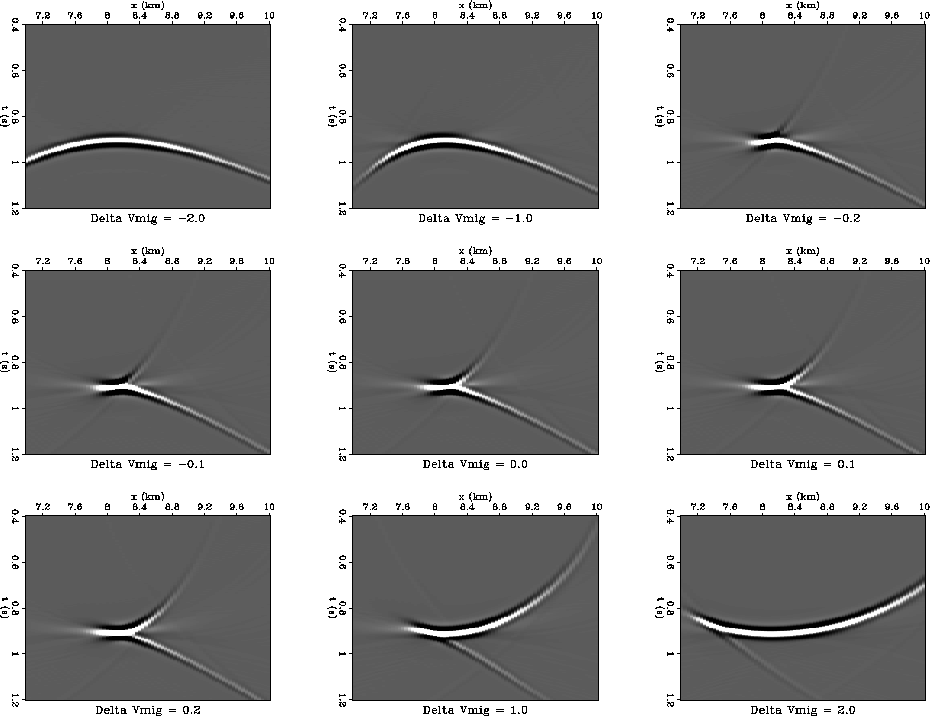




Next: AGREEMENT WITH GEOMETRICAL CONSTRUCTION
Up: VARIATION OF MIGRATION VELOCITY
Previous: Synthetic Model
In practice, it is difficult to choose the correct velocity for migration. It
is therefore instructive to see what effect the variation of migration velocity
has in a v(x) medium. The synthetic data from Paper 1 are migrated with
a Kirchhoff algorithm using various migration velocities and displayed in
Figure 3. Each frame is migrated using a different constant velocity.
The velocities used are 7.5 kft/s to 11.5 kft/s in increments of
0.5 kft/s.
The image changes from undermigrated in the
upper left corner to overmigrated in the lower right corner. The fourth frame
(Vmig=9.0) is migrated with a velocity close to the RMS well
velocity (8.84 kft/s) used in Figure 2.
As migration velocity is increased
the image begins to develop an upper limb in the third frame (Vmig=8.5)
of Figure 3. The plume is well formed in the fourth frame
(Vmig=9.0) and then appears to rotate clockwise as migration
velocity is increased. In the last frame the lower limb of the plume is very
faint and the image looks overmigrated.
By scrutinizing the frames of the movie in Figure 3, we can
see how the plume is formed. The left limb of the undermigrated image
in frame 1 (Vmig=7.5) gets swept upward and becomes the upper limb
of the plume in frame 4 (Vmig=9.0). Recall that the low velocity
wedge (Figure 1) has the effect of making the left side of the
true diffraction curve overmigrated and the right side undermigrated when
the RMS well
velocity is used. This overmigration sweeps the limb upwards.
The right limb of the undermigrated
image in frame 1 (Vmig=7.5) remains undermigrated as velocity
increases until the last few frames where the typical overmigration ``smile''
begins to form.
movie
Figure 3 Kirchhoff migration with a range of velocities. The constant
migration velocity ranges
from 7.5 kft/s to 11.5 kft/s. The RMS well velocity at the diffractor
position is 8.84 kft/s. If you have the electronic version of this report
you can click on the button and see a movie of the image as a function of
migration velocity. The movie begins with the true-diffraction curve
as the first frame and then sweeps through the images for migration velocities
ranging from 6.0 kft/s to 12.5 kft/s in steps of 0.5 kft/s.





The nature of plume variation with migration velocity is examined for
a different range of migration velocity with smaller
increments of migration velocity variation around the RMS well velocity
in Figure 4. The center
frame ( 0.0) is migrated with
the RMS well velocity of 8.84 kft/s. The image in the first two frames
is a characteristic undermigration ``frown'' and the image in the last frame
is a characteristic overmigration ``smile''. As in Figure 3,
we can see
the left side of the diffraction curve being swept up to form the upper limb
of the plume while the right side of the diffraction curve eventually forms
the left side of the ``smile''. Migration velocities close to the RMS
well velocity
frames 3 (
0.0) is migrated with
the RMS well velocity of 8.84 kft/s. The image in the first two frames
is a characteristic undermigration ``frown'' and the image in the last frame
is a characteristic overmigration ``smile''. As in Figure 3,
we can see
the left side of the diffraction curve being swept up to form the upper limb
of the plume while the right side of the diffraction curve eventually forms
the left side of the ``smile''. Migration velocities close to the RMS
well velocity
frames 3 ( -0.2)
through 7 (
-0.2)
through 7 ( 0.2) show the plume
rotating slightly clockwise, although the overall rotation trend
evident in frames 2 through 8 is somewhat counterclockwise.
0.2) show the plume
rotating slightly clockwise, although the overall rotation trend
evident in frames 2 through 8 is somewhat counterclockwise.
kfrot
Figure 4 Kirchhoff migration with various migration velocities. The center frame is
migrated with the RMS well velocity of 8.84 kft/s.
The other frames are migrated with velocities of  . The
. The  values are given under the
frame in units of kft/s.
values are given under the
frame in units of kft/s.










Next: AGREEMENT WITH GEOMETRICAL CONSTRUCTION
Up: VARIATION OF MIGRATION VELOCITY
Previous: Synthetic Model
Stanford Exploration Project
11/17/1997

